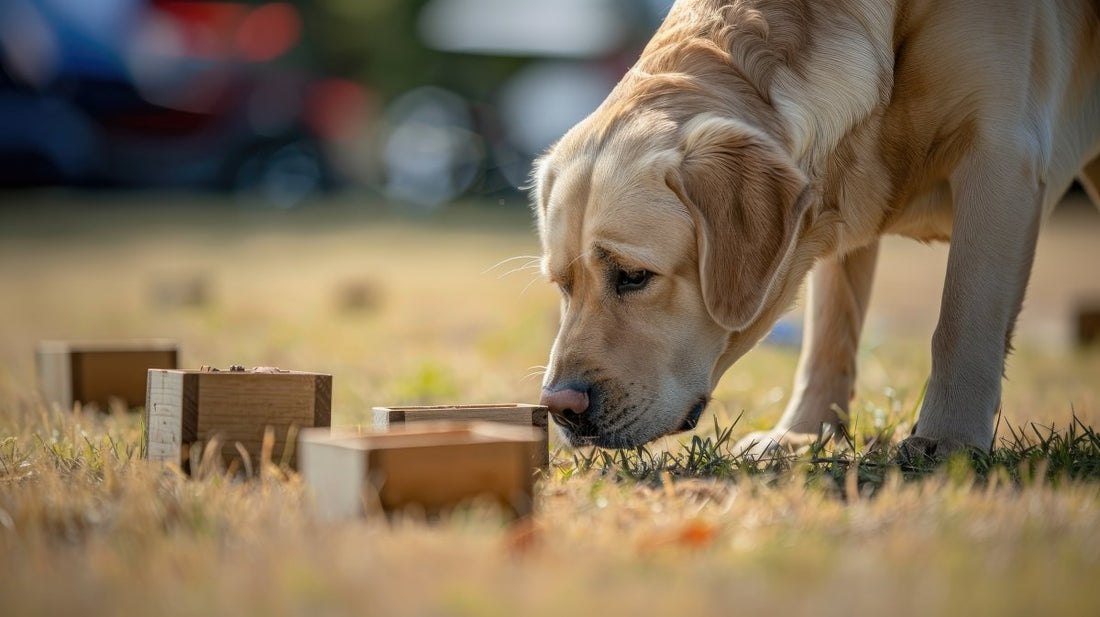Dogs perceive the world primarily through their noses. While humans have around five million olfactory cells, many dogs have up to 250 million. This means that for your dog, sniffing isn't just an activity, but an important part of his life.
With nose work, you can specifically promote this incredible ability – while ensuring exercise, fun, and bonding.
Why nose work is so useful
Nose work is a kind of "mental exercise" for dogs that does much more than just train their sense of smell. Engaging your dog with their nose
- physically and mentally demanding
- promotes concentration
- reduces stress and has a relaxing effect
- strengthens the bond between you and your dog
- is suitable for dogs of all breeds and ages
Whether in the living room, in the garden or in the forest – nose work can be done almost anywhere and often requires little equipment.
Possibilities of nose work
Simple nose work at home or in the garden
You don't need any professional training or special equipment to get started.
Here's how you can get started:
Treat search
- Show your dog the treat and let him sniff it.
- Place it visibly on the floor and say a signal word like “search.”
- When he finds it and eats it, praise him immediately.
- Increase slowly: Place the treat under a towel, behind a chair, or in a sniffing mat.
- Enlarge the search area step by step.
Box search
- Set up three empty boxes, one containing a treat.
- Lead your dog to the boxes and let him sniff.
- Reward immediately when he points to the correct box or looks inside.
- Later add more boxes and make them more difficult to place.
Laying a food trail
- Take small treats and leave a trail across the ground, for example, through the garden.
- Place your dog at the beginning of the trail and give the search signal.
- He is allowed to eat every piece along the way.
- Later, leave larger gaps between treats so that he has to search more with his nose.
Odor container
- Use small containers with holes or tea strainers.
- Fill them with a special scent (e.g. tea or herbs).
- Hide them slightly visible at first, then more and more difficult.
- Praise and reward when your dog finds the container.
Mantrailing – The search for people
In mantrailing, your dog searches for a specific person based on their individual scent.
Step-by-step training:
- Choose a known person as the “hiding person.”
- Take an odor carrier (e.g. a worn T-shirt) and let your dog sniff it.
- The person walks a few meters away and hides; the path there is easy for the dog to follow.
- Give the search signal and follow with the dog on a long leash.
- If he finds the person, there is a big reward and lots of praise.
- Increase difficulty: longer distances, different surfaces, more curves, later unknown people.
Tracking – tracking on the ground
Tracking is a targeted search on the ground.
There are two variants:
- Soil injury tracking: The dog follows the scent created by damaged plants or soil.
- Scent trail (drop trail): The dog follows a trail that has been deliberately laid with a scent, e.g., by drops of broth or food water.
Here's how you can get started:
- Lay a short, straight track across a meadow.
- Every few steps, place a small treat directly in the footprint.
- Place your dog at the beginning of the trail, give the signal, and keep him on a leash.
- He is allowed to pick up all the treats along the way – this motivates him to follow the trail.
- Once he becomes confident, only place treats every few meters.
- Increase difficulty: longer tracks, curves, different surfaces.
Item Search – Find specific objects
During object search, your dog learns to find and indicate a clearly defined object.
Training in small steps:
- Choose an object, such as a clothespin.
- Let your dog sniff it and reward immediately.
- Place the object visibly on the ground and give the search signal.
- Reward when he touches or looks at it.
- Later you partially hide the object (under a cloth, behind a chair).
- Even later, hide completely and expand the search radius.
Search for specific smells
This is where your dog learns to recognize a specific smell – for example, tea, tobacco, or spices.
This is how it works:
- Take a small container with holes and fill it with the target odor.
- Hold it out to the dog and reward immediately after he sniffs it.
- Place several empty containers and one with the target odor.
- Praise and reward only when the dog indicates the correct one.
- Increase the difficulty: place containers further apart, hide them in different places.
Conclusion: Sniffing makes you happy
Nose work is one of the most species-appropriate and beneficial activities for dogs. Whether it's simply searching for treats at home, mantrailing in the field, tracking in the forest, finding specific objects, or searching for specific smells – sniffing training offers your dog mental stimulation, fun, and shared experiences. And best of all: You can start right away, no matter where you are.
Want to learn more about a dog's nose? Check it out here .



